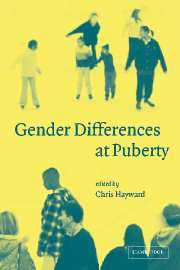Book contents
- Frontmatter
- Contents
- List of figures
- List of tables
- List of contributors
- Preface
- Acknowledgments
- 1 Methodological concerns in puberty-related research
- Part 1 Sex differences in hormones and their effect at puberty
- Part 2 Girls at puberty
- Part 3 Boys at puberty
- Part 4 Puberty and psychopathology
- Part 5 Pubertal timing: antecedents
- Part 6 Pubertal timing: consequences
- 12 Short-term and long-term consequences of early versus late physical maturation in adolescents
- 13 When coming of age means coming undone: links between puberty and psychosocial adjustment among European American and African American girls
- Part 7 Puberty and context
- Index
- References
13 - When coming of age means coming undone: links between puberty and psychosocial adjustment among European American and African American girls
Published online by Cambridge University Press: 22 September 2009
- Frontmatter
- Contents
- List of figures
- List of tables
- List of contributors
- Preface
- Acknowledgments
- 1 Methodological concerns in puberty-related research
- Part 1 Sex differences in hormones and their effect at puberty
- Part 2 Girls at puberty
- Part 3 Boys at puberty
- Part 4 Puberty and psychopathology
- Part 5 Pubertal timing: antecedents
- Part 6 Pubertal timing: consequences
- 12 Short-term and long-term consequences of early versus late physical maturation in adolescents
- 13 When coming of age means coming undone: links between puberty and psychosocial adjustment among European American and African American girls
- Part 7 Puberty and context
- Index
- References
Summary
What does “coming undone” look like among European American and African American girls?
Societal concerns for boys and girls during their teenage years tend to be compartmentalized into a stereotyped dichotomy, where our concerns for boys typically center around problems such as delinquency, gang involvement, school disengagement, and substance abuse, and our concerns for girls are typically more inclined toward the internalizing spectrum, such as depression, eating disorders, or low self-esteem. To use recent examples in the psychological literature, adolescent boys may become lost in rage and disconnection and end up imprisoned, literally (Garbarino, 1999), while girls are at risk of being figuratively imprisoned by the social surrounds that leave them with low self-esteem, diminished sense of agency, depressed, and despondent (Pipher, 1994).
Similarly, the pitfalls most frequently encountered by adolescent girls have been described and investigated within a dichotomy of race/ethnicity and class. In the world of European American middle- and upper-class girls, concerns continue to center around the development of internalizing spectrum mental health difficulties: eating disorders, depression, low self-esteem, and disturbed body image. In contrast, African American (or ethnic minority or impoverished) adolescent girls are viewed to be most at risk for the development of more externalizing manifestations of adolescent problems, such as delinquency, school disengagement, early or risky sexual behavior, or teen pregnancy.
As is the case for most stereotypes, there is some foundation for this dichotomy when current estimates of mental disorder and social behavior are considered.
- Type
- Chapter
- Information
- Gender Differences at Puberty , pp. 277 - 304Publisher: Cambridge University PressPrint publication year: 2003
References
- 16
- Cited by



